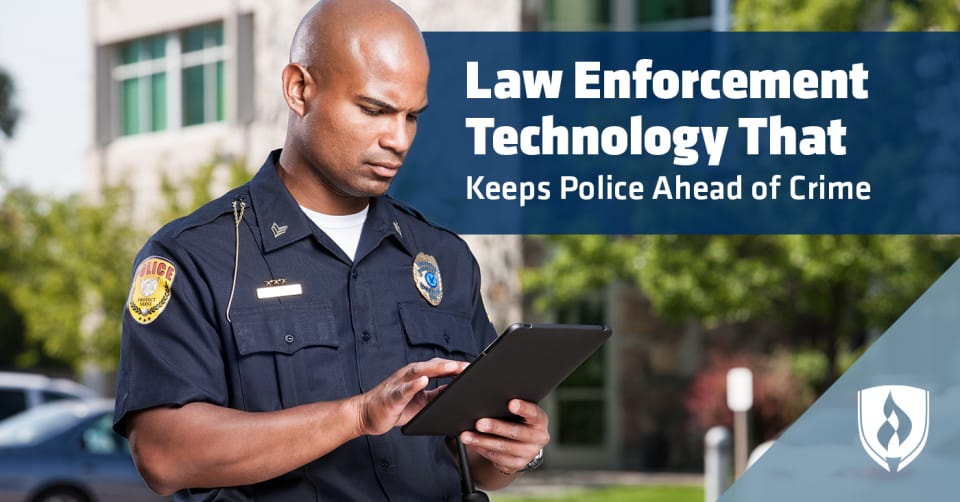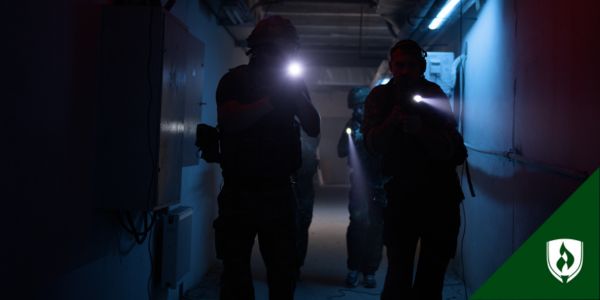
Working as a police officer used to be a career associated with routine traffic stops and piles of desk work. But today, that’s all changed. Law enforcement technology is making its mark on police departments around the country as new-and-improved gadgets are becoming available to help officers prevent crime.
If you’re looking to stand out in an action-packed career that allows you to explore your love for technology, law enforcement may be the best of both worlds. Imagine achieving success while impacting your community and getting your hands on some cutting-edge law enforcement technology. We’re breaking down the top gadgets law enforcement officers can use to do their jobs and make your neighborhood a safer place.
Technology in law enforcement: 8 Innovative gadgets powering police
Law enforcement officers deserve access to the best tech available to help them fight crime—and they’re getting it! We’ve rounded up eight top-of-the-line technologies that police officers are using every day.
1. Robotic cameras
Police officers can’t be everywhere at once at a crime scene, and some situations are too dangerous to risk sending officers. That’s why robots have been specially designed to deploy into places officers can’t reach safely.
Driving a remote-controlled robot is no longer a childhood dream, thanks to this robotic camera. Officers can throw them into hard-to-reach areas or places without a clear line of sight and operate it wirelessly from safety. Officers are making use of this robotic technology to detect bombs or search suspicious homes and vehicles. With an electric motor and special wheels that allow it to move, climb and explore, this robotic camera is helping to keep officers out of harm’s way.
2. Handheld lasers
Law enforcement agencies are now using handheld lasers in crime scene investigations. Sorry, sci-fi fans—they’re probably not the type of lasers you’re picturing. Handheld laser spectroscopy devices can determine the chemical composition of an unknown substance within seconds. If an officer comes across a suspicious substance, these devices will reveal the chemical makeup almost immediately.
This type of instantaneous law enforcement technology is decreasing the time officers need to be in the office or in the lab, allowing for more time in action. These lasers are also keeping officers safe from harmful substances they may not have recognized otherwise.
3. Automatic license plate recognition
Those letters and numbers on our cars help law enforcement officers determine if vehicles are stolen or if the owners are wanted. New technology streamlines this process. The automatic license plate recognition (ALPR) system is an integrated camera-database technology, meaning the system takes a picture of a car’s license plate and then processes the numbers and letters against a known database, alerting the officer if a vehicle is suspicious.
The ALPR can identify, screen and record the license plates of more vehicles than an entire squad of police officers could handle—with greater accuracy and no fatigue factor, according to POLICE Magazine. That means more wanted vehicles apprehended in less time, making this piece of law enforcement technology something no officer wants to do without.
4. Unmanned aircraft systems (UAS)
If you thought remote control camera robots were cool, you’ll be excited to hear that some law enforcement agencies have experimented with using unmanned aircraft systems (UAS), sometimes known as drones. The UAS could be used to search for suspects, obtain information and survey disaster areas without using a piloted helicopter or plane. Not only could UAS technology save money, but it also has the potential to keep law enforcement officers out of harm’s way.
While this technology in law enforcement is currently available, the widespread use of unmanned aircrafts has been slow to take off due to regulations and critique from members the public. Only time will tell if these unmanned aircraft will become a widespread part of our law enforcement.
5. Tablets
That’s right—one integral piece of law enforcement technology is one you may have sitting on your desk right now: iPads and other tablets. It may not seem like much, but ever since iPads have been introduced to police departments around the country, officers’ job have become increasingly more versatile.
iPads allow officers to do just about anything away from their department desk, making what was once desk work possible on the go. Officers can now file accident and incident reports wirelessly, look up photos of suspects and access other information in a state crime database—all from their car or a crime scene.
This kind of mobility makes a much bigger difference in law enforcement than it would it most jobs. With less time spent at their desks, officers have more availability to actively patrol the streets and prevent crime.
6. GPS vehicle-pursuit dart
Imagine the classic car-chase scene: Police cruisers careening after one wild driver with helicopters following from above. It’s a dangerous situation, full of dangerous variables. Law enforcement agencies are working to prevent this by developing a GPS vehicle-pursuit dart. This new law enforcement technology shoots a special GPS-equipped dart that sticks to a fleeing vehicle and lets authorities track the vehicle's movements without a frantic pursuit, according to Computerworld.
This new device is still being developed and fine-tuned for law enforcement use, but hopefully it will soon be available to make our streets (and pursuit scenarios) safer.
7. Thermal imaging
It might sound like a tool you’d find in the Batcave, but the thermal imaging technology we use in the medical world has made its way to the crime scene. This law enforcement technology gives police officers the ability to see a thermal view of their surroundings, offering an identifiable and reliable “heat picture” of their environment. This small, handheld device can help officers locate suspects hiding in a dark building, investigate crime scenes and conduct search and rescue operations.
Not only do thermal imaging devices have the ability to improve officers’ efficiency while investigating a crime scene, but it could also make a world of difference for citizens, too. Imagine a child or senior citizen lost in a snowstorm where visibility is at a minimum—a thermal imaging device can be a lifesaver in this situation.
8. Gunshot detection systems
Now being implemented in a few U.S. cities, the gunshot detection systems (GDS), or ShotSpotter, is a system that shows police officers where a gunshot has just been fired. This new and still-improving technology uses sensitive audio sensors placed around a neighborhood to detect gunshots and show officers the exact location.
This law enforcement technology helps officers respond faster to gunshot incidents, which gives them a leg-up on assisting victims and tracking down suspects. GDS technology has the potential to make communities much safer, especially in areas where there aren’t enough officers to be on patrol 24/7.
Law enforcement officer and technology specialist
All of this new law enforcement technology means that police officers are doing a lot more than making routine traffic stops and laboring over piles of paperwork. Now that you know about exciting law enforcement technology like thermal imagery and wireless cameras, you may be itching to get your hands on these gadgets as a law enforcement officer.
Check out some of the most popular jobs in criminal justice to learn more about a career in law enforcement.
RELATED ARTICLES:




